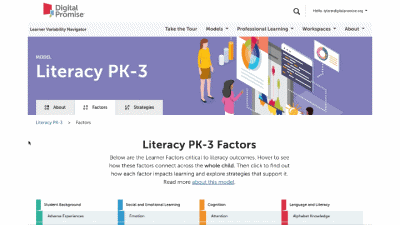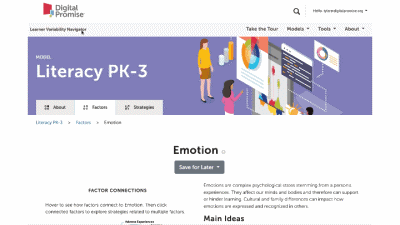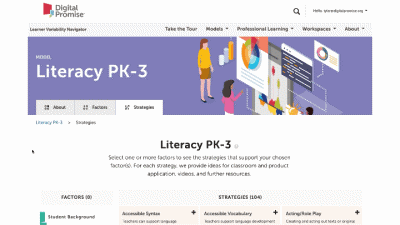Given the robust nature of learning sciences research, this website is best viewed on tablets and computers. A small screen experience is coming in the future.
On June 22, 2021, we will launch updated strategies for the Math PK-2 model, as well as additional updates to the Navigator that highlight equity, SEL, and culturally responsive teaching. To learn more, visit our Site Updates (available in the "About" menu at the top of any page).

Hover to see how factors connect to Collaboration. Then click connected factors to explore strategies related to multiple factors.
Collaboration is the ability to work effectively and respectfully with diverse teams. It involves the ability to exercise flexibility and making compromises to accomplish a common goal along with a shared responsibility for collaborative work. It also includes children's ability to express their own, and listen to others' thoughts and ideas or needs. Collaboration can be influenced by various factors, including characteristics of the child, the immediate and surrounding context, and the larger cultural setting. How children engage in Collaboration is often guided by their understanding of social norms across contexts, and cultural socialization practices and expectations. Therefore children across different backgrounds may engage in peer Collaboration differently, as might children who have difficulty gauging social cues due to language-based learning disabilities or ADHD. While inattentiveness and impulsivity are often barriers to engagement for children with ADHD, research has also found that even young children with ADHD who don't display perceived “behavior problems” are still often less engaged. When children are able to learn with and from each other this can strengthen their Social Awareness and Relationship Skills. Collaboration helps students to think more deeply and creatively, make friends, learn at school and beyond, and form beliefs about the world and others.
Project-based learning (PBL) actively engages learners in authentic tasks designed to create products or design solutions that answer a given question or solve a problem.
Students explaining their thinking during learning is a metacognitive process that involves actively self-questioning or being questioned while exploring new concepts, and explaining thoughts and reasoning in response.
Games support learning as learners engage with new information in fun and informal ways.
Guided play is when a child is actively engaged in a playful learning environment, with an adult supporting their play and learning.
Gallery walks are ways of showcasing content and materials as multiple “exhibitions” for students to view and interact with as part of larger learning goals.
Flexible grouping is a classroom practice that temporarily places students together in given groups to work together, with the purpose of achieving a given learning goal or activity.
As learners work together to solve problems, they learn new strategies and practice Communication skills as they express their academic thinking.
Think-Pair-Share (TPS), also known as Turn & Talk (T&T), is when the teacher pauses instruction so students can discuss a topic or prompt in pairs or small groups, to enhance engagement, language development, and learning outcomes.
Communication boards are displays of graphics (e.g., pictures, symbols, illustrations) and/or words where learners can gesture, touch, or point to the displays to extend their expressive language potential.
Using motions to explain new concepts or ideas supports the ability to process new information and to convey thinking and conceptual understanding.
Music and dance supports young learners in a myriad of ways, including supporting their engagement and motivation, connecting with cultural background, and offering structure during play.
Music and dance supports young learners in a myriad of ways, including supporting their engagement and motivation, connecting with cultural background, and offering structure during play.
Discussing emotions with children consists of supporting their ability to identify, label, and manage their feelings.
Developing cultural awareness as an educator is an ongoing process that includes a recognition and appreciation for the full diversity of students and an understanding of how one's own Identity intersects with students' identities.
Equitable grading systems and practices reimagine how to communicate student progress and mastery through various methods that reduce subjectivity and increase opportunities to learn.
Translanguaging is a flexible classroom practice enabling students to listen, speak, read, and write across their multiple languages or dialects, even if the teacher does not have formal knowledge of these additional languages.
Feedback is the process of providing learners with information about their learning to support their progress and improvement, which can come from a range of sources, including teachers and peers.
A rubric is a tool that communicates expectations for success for students and can include symbols or charts that are easy for young students to understand.
Flexible seating refers to the practice of offering students a range of work surfaces, seating sizes and heights, movement, and varied body positions in the classroom.
Interactive writing activities for young learners can include cooperative activities to practice their foundational writing skills and can support engagement with content knowledge as they write and draw to reflect upon what they have learned.
Spaced practice is a learning strategy that deliberately spaces out learning or study sessions over varying periods of time, with the purpose of increasing retention, understanding, and long-term knowledge acquisition.
Retrieval practice requires students to access information, or get information “out” from Long-term memory in order to support better retention and understanding.
Building positive and trusting relationships with learners fosters a Sense of Belonging, safety, and engagement, laying the groundwork for academic, cognitive, and social-emotional growth.
Pre-assessments are tools or activities used before instruction begins to help educators understand what students already know, understand, or can do—and where they may need support.
When classrooms are intentionally designed to promote inclusion, belonging, and accessibility, they positively influence key learner factors, including Attention, Self-Regulation, Learner Mindset, and Sense of Belonging.
 Except where otherwise noted, content on this site is licensed under a Creative Commons Attribution-NonCommercial 4.0 International License
Except where otherwise noted, content on this site is licensed under a Creative Commons Attribution-NonCommercial 4.0 International License





This is our homepage. You can access many of the features of the Navigator here, and learn more about how learner variability intersects with topics in education and learning. To start, select a content area – we call them Learner Models – to visit a factor map.
Factor maps show research-based concepts, "factors," that likely impact learning. They are organized into four categories: Learner Background, Social and Emotional Learning, Cognition, and Content Area. The map is interactive. Move your cursor over a factor to see connected factors. Select any factor to visit its summary page. We'll look at factor summary pages next.
This is a factor summary page. It provides a brief definition and review of the factor, a factor connections diagram, additional resources, and strategies that support this factor. On the strategy card, the multi-colored boxes show all the factors that it supports. Select a strategy to visit its summary page.
Strategy summary pages have an overview, information about using the strategy in different learning environments, resources of interest, the factors this strategy supports, and related strategies you can explore. To view all the strategies in a content area, use the strategies tab at the top of the page. We'll look at all the Strategies for this learner model next.
The strategy page shows ALL of the strategies for that learner model. You can select factors of interest for you or your learners, and it will narrow the strategies to only those that match all of the factors selected. This makes it easy to find key strategies to better design for learner variability. Again, select the strategy name to visit its summary page.
Are you sure you want to delete this Workspace?
Enter the email address of the person you want to share with. This person will be granted access to this workspace and will be able to view and edit it.
Adjust the permissions of your Workspace.
This Workspace is .
This Workspace's Reflection Area is .
Learner variability is the recognition that each learner is a unique constellation of strengths and challenges that are interconnected across the whole child. Understanding these connections and how they vary according to context is essential for meeting the needs of each learner.
It disrupts the notion of a one-size-fits all education. Understanding learner variability helps educators embrace both students’ struggles and strengths as we connect practice to uplifting the whole learner.
Throughout the site, we talk about "factors" and "strategies." Factors are concepts research suggests have an impact on how people learn. Strategies are the approaches to teaching and learning that can be used to support people in how they learn best.
Use the Learner Centered Design Tool to build a workspace. Go to Learner Centered Design Tool.
Or, create a new blank workspace for your product or project.
Use one of the guided tools to build a workspace.
Or, create a new blank workspace for your product or project.
Make a copy of this workspace.
Redirecting soon...
Generating summary page
Loading...
On this page, using your heatmap, you will be asked to select factors to further explore, and then select new strategies you might incorporate into upcoming instruction. Once done, click “Show Summary" to view your Design Summary Report.
On this page, using your heatmap, you will be asked to select factors to further explore, and then select new strategies you might incorporate into upcoming instruction. Once done, click “Show Report” to view your Design Summary Report.
By selecting "Show Report" you will be taken to the Assessment Summary Page. Once created, you will not be able to edit your report. If you select cancel below, you can continue to edit your factor and strategy selections.
Announcement here
Item successfully added to workspace!
Issue adding item to workspace. Please refresh the page and try again.
Learner variability is the recognition that each learner is a unique constellation of strengths and challenges that are interconnected across the whole child. Understanding these connections and how they vary according to context is essential for meeting the needs of each learner. It embraces both students’ struggles and strengths. It considers the whole child.
Throughout the site, we talk about "factors" and "strategies." Factors are concepts research suggests have an impact on how people learn. Strategies are the approaches to teaching and learning that can be used to support people in how they learn best.
The Learner Variability Navigator is a free, online tool that translates the science of learner variability into factor maps and strategies that highlight connections across the whole learner. This puts the science of learning at teachers' fingertips, empowering them to understand their own practice and support each learner.